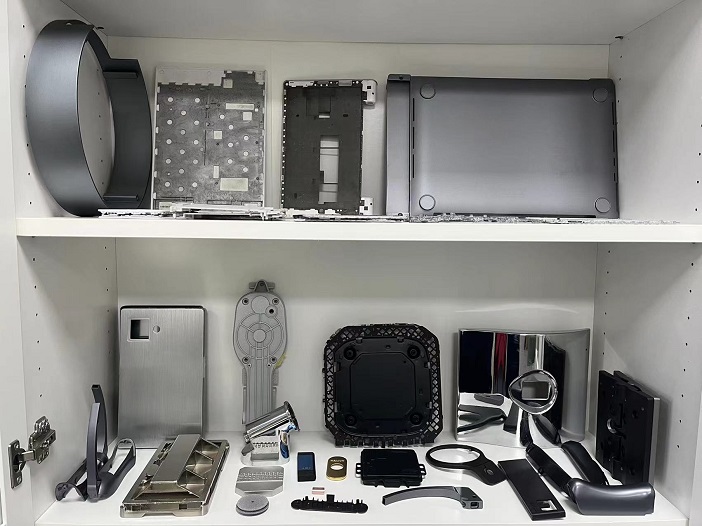No surprise that we are surrounded by varied products all the time and everywhere. Some look matte, others look glossy. Some look metallic, others look colored. Assuming we are under the normal day-light, the looks of an object depend mainly on one thing – its surface finish. The surface finish serves as a protection against the external impacts, preventing contamination or oxidation from long term application. All surface finishes have their own strengths and drawbacks, so it’s critical to choose the right one for the product manufacturing, considering the appearance, functionality and assembly processes etc.

In this article we are going to explore those common surface finishes in our manufacturing, along with the different techniques to achieve effects.
- As machined
As machined is the natural surface finish that is an economic and quick application, usually applied for non-display or invisible surfaces. A machined surface finish part, whose standard value of roughness(Ra) is 3.2 μm, is more than adequate for end-use applications in many cases, but if you are expected to reduce the surface roughness to 0.8, 0.4 μm or lower for either aesthetic or functional purposes, it must be modified through additional processing steps that results in higher production cost.

Polishing
If you need a smooth, non-textured finish, a buff polishing machine might be the way to go. This machine buffs the product’s surface with a cloth wheel, resulting in a high, glossy finish. The method is frequently used for decorative items that require gloss and smoothness. Buff polishing machines tend to smooth out a product’s edges, and the procedure is less successful for applications requiring delicate, fragile, or recessed features due to the cloth wheel’s range limitations.

Anodizing
Anodizing is an electrochemical technique that turns a metal surface into an anodic oxide finish that is decorative, long-lasting and corrosion-resistant. As known to all, aluminum is ideal for anodizing, other nonferrous metals like magnesium and titanium can be anodized as well. The anodic oxide structure is made completely of aluminum oxide and is derived from the aluminum substrate. This aluminum oxide isn’t applied to the surface like paint or plating; instead, it’s totally merged with the underlying aluminum substrate, so it won’t chip or peel. It has a porous, highly organized structure that allows secondary processes like coloring and sealing to take place.

Brushing
Brush metal finishing, unlike plating, is an effective secondary process for removing surface defects. To smooth out a product’s exterior, this finishing process generates a uniform, parallel grain surface texture. To generate this effect, an abrasive belt or wire brush is frequently used. Furthermore, the belt or brush’s single direction can result in slightly rounded edges perpendicular to the grain.

Powder Coating
Powder coating creates a decorative finish that is similar to painting but with greater durability. The method entails melting dry plastic powder onto metal to create a textured, matte, or glossy finish. A textured powder-coating process can also be used to cover up existing surface flaws in a simple and effective manner.

Sand Blasting
Sandblasting process is commonly used in projects that require a consistent matte texture. Sand, steel shots, metal pellets, or other abrasives are blasted into a substrate at high speeds in this process (also known as bead blasting). It produces a smooth, clean product texture, which is especially noticeable in soft metals.

Plating
Plating process coats or changes the surface of a substrate with a thin layer of metal, such as nickel or zinc, using a chemical bath. Electroplating coats the substrate with an electric current, whereas electroless plating uses an autocatalytic approach where the substrate catalyzes the reaction. As a finishing technique, plating has a number of advantages, including improving a product’s durability, corrosion resistance, surface friction, and exterior appearance. Plating process, on the other hand, aren’t designed to smooth out surface flaws.

Blackening
Blackening process applies a thin coating of black oxide over a product’s surface to generate a matte black finish with exceptional abrasion resistance. The product is placed into a sequence of tanks containing cleansers, caustics, and coolants during the high-temperature procedure.

Conclusion
Choosing the right Surface Finish for your product application is just as crucial as selecting the right manufacturer to produce your product. If unfortunately you use the wrong Surface Finish, you could experience problems during product assembly or longer-term application. After your component has been designed, you may be thinking about different surface finishes. To save you money and expedite your business, we want to provide you with a finished part that can be inserted right into your assembly process rather than a raw part. At GEMS Manufacturing we offer the ultimate value-added service in secondary operations for Surface Finish.